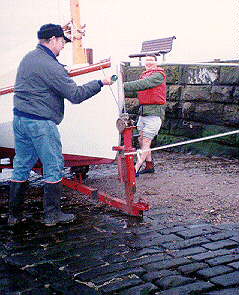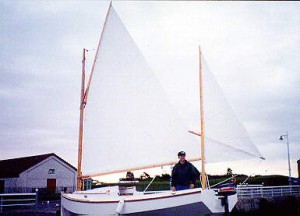Chebacco News
Number 10, July 1996
‘Sylvester’ hits the water!
Your editor’s sheet ply Chebacco-20, ‘Sylvester’, hit the water for the first time on 6th May 1996. This is the first Chebacco to be launched in the UK and is now nodding at her mooring in the Tay estuary, here in Bonnie Scotland. “Why ‘Sylvester’?” I seem to hear you say. (Or, possibly, “What a bloody awful name for a boat.”) Since the Chebacco is technically a cat yawl, and catboats are almost non-existent on this side of the pond, I decided to call her after a well-known cat. My tender, when launched will, of course, be ‘Tweety Pie’. I’ll now bore you with some excruciating detail.
It’s always been a worry to me that she might not get out of the garden. I’d made models and tried it out with them, but it was never clear that it’d get around the dogleg by the garage. I planned to hire a crane to lift it over the garage, but when the crane arrived, it was 4” too wide to fit down the drive. After a couple of nights tossing and turning I got a rusty old dinghy trailer, with collapsed suspension, and moved bits of it around so that the Chebacco might fit. She did fit, and was even nose heavy when I put some junk up for’ard in the cuddy. She JUST made it past the garage (an inch to spare) with help from my glamorous assistants, Sheila and Esther. Since the trailing arrangement didn’t quite meet the letter (or even the spirit) of the law, I decide to launch when traffic was minimal – at 5 am. Three friends, Louis, Donald and Paul were mad enough to get up at that ungodly hour to help. I trailed her down to the harbour (just a mile from home) without incident, at 5 mph. I drove back home for the tender (a very heavy 15 foot skiff) and spars, sails, outboard etc. The mast was raised (Phil’s slot works well) and gaff, boom, mizzenmast and sails were put in place. Everything was raised on shore to make sure the ropes weren’t tangled up.
She slipped quietly into the water and we moored her in the harbour temporarily:
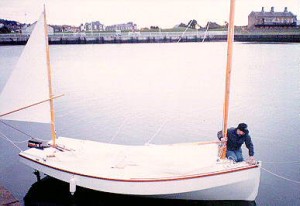
Moored in the harbour at Broughty Ferry, Scotland
We then motored upriver to my mooring (which had been prepared previously) hooked her on and nervously left her to it.
First impressions:
Several of you have asked me “What about the weather helm?”. I am happy to assert that it hasn’t been a problem for me. I’ve been out sailing in ‘Sylvester’ nine times to date, in conditions ranging from flat calm to force 5. Weather helm only becomes noticable when she heels a lot. When I’ve had a crew sitting on the weather side with me this has never happened. Sailing single-handed she begins to heel uncomfortably under full sail at about force 4 and the answer is either to spill wind or take in a reef.
On the wind she points high and makes good progress to windward. I’ve sailed in company with ‘Wayfarer’ dinghies and do as well as them to windward, and somewhat better off the wind. I’ve even sailed alongside a 25 foot (heavy) Bermudan sloop and did better in a force 2/3 wind. I daresay the sloop would have done better in a heavier blow.
For the record, my mainsail has maximum draft about 30% back from the luff and the mizzen is cut dead flat.
Downwind, some concentration is needed in heavy weather to keep her running straight. Her performance is exhilarating when surfing down good sized waves! She has little or no tendency to roll when in a dead run. Gybing is straightforward and gives me no anxiety (even when it is accidental). On the wind, she tacks like a dinghy; with no tendency to stick in irons.
A New Chebacco?
Phil and Susanne wrote to me a few weeks ago:
How much interest do you suppose there would be in a “cruising” version of the Chebacco, with a longer cabin, a shorter cockpit, and a raised deck for more space inside and more reserve buoyancy? . . . It seems offhand to be workable without major changes in the class.
My own view is that the ordinary Chebacco-20 suits me nicely. A nice big cockpit for lots of folk daysailing is worth more to me than a seldom used roomier cabin. On the other hand the big cockpit is a pain in that it isn’t self draining and so I need to fit a cover over it whenever I leave the boat on its mooring. Room in the cabin is adequate for a short-arsed individual like me though I can see the attractions of more head-room and possibly room for cooking, reading charts, permanent potty site and so on. Nevertheless, if I was starting over I’d still go for the sheet ply Chebacco-20.
In order to quickly sound out a sample of Chebacco fans, I sent an email to some of you for your reaction. Here are some of them, in no particular order.
Gil Fizhugh writes:
I think Phil’s proposed cruising Chebacco would be an improvement.
The main drawback of the 20-foot Chebacco now is that they’re awfully cramped for those of us who aren’t “short arsed” [Gil is quoting my own description of my stature back at me – B.S.]. Joan used to enjoy camping. She hasn’t done any since she’s known me because I’m turned off by the whole idea. I’ve thought it might be fun to spend a night in the Chebacco once in a while, dry under the roof and with a potty close to hand. I wouldn’t have to lug my sleeping and cooking accommodations to where I was going to use them, on my back. But the Chebacco cabin is going to be awfully tight.
If the 25-foot plans had been available when I started, I probably would be building it now. I presume the materials would cost 30% or so more, including a bigger engine. Spread out over the number of years I’m managing to fritter away on this project, that’s not a big deal. (If I had to add 30% in a lump sum on top of the already high cost of having a Chebacco commercially built, it would be a very big deal indeed!) The 25-footer has the reserve buoyancy and enough cabin space for two tall people to be comfortable – well, almost. There remains one major problem with the 25-footer: it’s beyond the size and weight that can comfortably be towed by an ordinary car. My boating suddenly gets much more expensive if I have to buy, feed and maintain a Ford Explorer for 100% of my driving, because the Subaru can’t do the job in the 5% of my driving that’s done with a boat on the back end. Not many family cars weigh 2 1/2 tons and have 6-liter V-8’s any more.
So the proposed boat would be roughly a 20-footer with the cabin space of the 25, the sacrifice being a small cockpit instead of a small cabin. This would be a 2-person boat (or singlehander) all the time, because daysailing with more than two adults in a little aft cockpit would put too much weight in the tail, wouldn’t it? Still, if I were starting over, I think I’d prefer such an option – a boat well- balanced for sailing and camping for two, rather than great for sailing for six but cramped for camping for two.
I’m curious about what Phil means by a “cruising” version. If he just means one that’s comfortable for more than one night on board, the proposal is an improvement. But what’s the extra reserve buoyancy for? I hope my boat will be adequately buoyant for sailing in Maine, Cape Cod, the Chesapeake, . . . Is the new one to be an offshore boat? Through the Gulf Stream to the Bahamas? Still an unballasted gunkholer? I shall try to open my mind so Phil can pour his genius in.
Best regards,
Gil
Fraser Howell writes: Bill, I agree with you. I like Chebacco as a “camp cruiser”. I don’t like the boxy version of the Chebacco that was shown in P. B.’s latest book, although I have been thinking about a self-bailing cockpit, but that would be a later modification.
Brad (NADER2@delphi.com) says:
This sounds like a good idea to me at least. I think if I could only have one boat I’d rather daysail a cruiser than cruise a daysailer.
Jamie Orr writes:
. . . my first reaction is “no thanks”. I think this is because the current version is close to my idea of the perfect boat. Any design is a host of compromises, and I like the choices already made. These are (not in any order of preference):
- Trailerable – light with no ballast, shallow keel, not more than 20 feet overall.
- Shallow draft for ease of landing on interesting beaches, islands.
- Big cockpit – that’s where most of the time is spent – I won’t give that up.
- Simple to rig – no standing rigging certainly meets that one!
- Simple and relatively inexpensive to build.
- A place for the crew to get out of the rain. I feel the boat already has the ability to cruise if helped
- out by a boom tent or tent ashore. If two can cruise comfortably for 10 days in a 16 foot canoe, a
- Chebacco should be palatial, even for four. (Mind you, the raised deck sounds like it could be a good
- idea.)
- Good looking – the lines caught my eye back in 1991, and I still find them attractive.
Right now I’m still building my Chebacco, so most of my likes and dislikes are based on prejudice, not experience. We like camping, so a minimal approach seems right. Otherwise for serious cruising I would probably look for a larger boat altogether. In that case I would go the whole hog and look for an enclosed head, galley arrangements, and four berths below. I would probably charter a boat like that once a year, and keep the small boat for daysailing the rest of the year.
If I was to dream about a cruising Chebacco, I would abandon the 20 foot limitation – how about a 30-footer with the same proportions and sail plan – maybe an inboard engine, a self-draining cockpit if it could be done while keeping that sheerline . . .
Of course, I’d have to dream up some added cash, too.
Jamie Orr
Bill Parkes says:
What prompted PCB to propose the cruising Chebacco idea? It strikes me as an excellent notion. I very nearly fell for the glass-house version. There is, I think, more cockpit space than I would ever need in the Chebacco-20.
What is he proposing?
- conventional plywood or lapstrake?
- long ballast keel (like the glass-house version)?
- a cabin configuration like the 25?
Happy sailing!
Bill,
Harrisburg
So there we have it. We await developments with interest . . .
Who’d be a boat designer?
Chuck Merrell of Seattle reads Chebacco News. He lives aboard a ‘Jessie Cooper’ that he built himself and is thinking of getting into the boat design business. Reading his letter makes me appreciate what Phil has to put up with! Now read on . . .
Hi Bill,
Having inserted a toe into the idea of the design business (after telling myself I’d never do it), I’ve grown to believe that Phil’s policy of having an unlisted phone number might be a stroke of genius. Ted Brewer also went through an un-listed phone period lately.
As late as yesterday, I had a meeting with a potential dinghy plans customer, and the conversation went like this:
Him: “Gee, that’s a neat design, I’m gonna build one . . . but whatja put that keel on it for? I’d build in a centerboard if for no other reason than the trunk would support the athwartships seat for my girlfriend, and other seats so I could haul me and two others to the beach from my cruiser, you know drink beer, toss a shrimp on the barby–all that.”
Me: “Well, the idea behind this dink is that it is to be sailed primarily by oneperson, and you’re supposed to sit on a cushion with the inside of the boat uncluttered so you could move around and it would be easier to sail–not to mention lowering the center of gravity by sitting in the bottom on a soft cushion.”
Him: Well, it looks pretty light . . . but I’ll bet that if I put my 25 horsepower Evinrude on the transom that sucker’d really really fly, maybe twenty or twenty five huh?”
Me: ” Not really, the bottom of the boat is designed for sailing speeds, and the aft sections are prismatically correct for lively go-fast performance and helm stability particularly on a down wind run.”
Him: “How fast is “go-fast”?
Me: “Well, even though the boat is only seven and a half feet long, you could probably get six, seven knots under good conditions.”
Him: “God, that’d take forever to get from where I anchor in Mystery Bay to the store for a beer run. Maybe I just ought to just buy a Livingston. They don’t row very well, or sail very well, or tow very well, but they’ll handle three grown-ups (!?) and two racks a’ beer with three or four inches of freeboard, and still make 20 knots with my 25 Evie. Still . . . those Livingston’s are pretty pricey . . . I bet I could build yours for a hundred bucks if I could get the plans for ten bucks or so, whadda ya say”?
Me: (Mentally filling out an Employment Application for the shoe store down the street) “Well, actually, I don’t really think this is the boat for you, but why don’t you ask about Livingston’s at the office. I think they have a couple used ones you could get really cheap”.
Him: (Heading for the door) ” Wow! Really? Terriffic! Great! Glad they sent me over! They told me you really know what you’re talking about! Hey, gotta check that out . . . maybe a lee board, you know one of those snap on kind like on a Livingston might be better than that keel, though. I know about this design crap. I been ‘bashin’ the Sound since you were in diapers. Catch ya later!”
**Fade To Black**
Bottom line: I’m not sure that hostile criticism from those in the diaspora stands up especially in reference to a “trial baloon”. The war waging inside me right now is: “If I were going to do this stuff for profit, should I (like 95% of the other designers) meet plan buyers at the door with sheep shears, suffer the inevitable lumps with aplomb and have a much better looking exchequer at years end?
Chuck
Photos from Australia:
Peter Gray has sent me some photos of Gray Feather, which is now fully rigged. He reports that he is very happy with her sailing performance, especially in heavy weather.
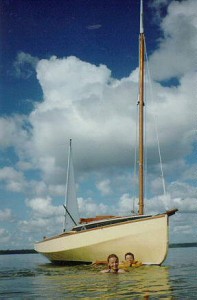
Gray Feather as a swimming platform?
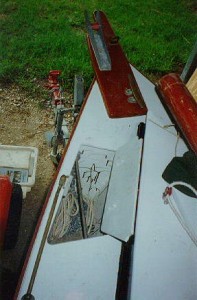 Peter has put a box for the anchor under the side deck.
Peter has put a box for the anchor under the side deck.
Stop Press: Peter entered Gray Feather in the Sandgate Gaff Vintage regatta and was placed 7th out of 19 boats (on handicap).
And from Canada . . .
Fraser Howell is making excellent progress with his strip-planked Chebacco. She’s strip planked in half inch fir, with 1/8” ash veneers epoxied over the strips and sealed in epoxy:
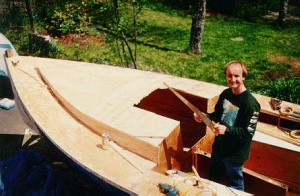
The coachroof is strip planked and veneered
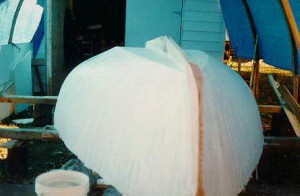
Fraser’s strip-planked hull has been veneered with ash
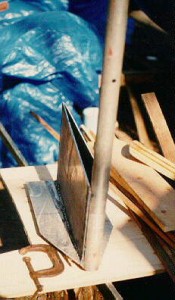
Fraser’s rudder is welded up in aluminium
Stop Press (27 June) – Fraser plans to launch any day now!
And finally . . .
That’s all for this time. You may have noticed there’s been a longer gap than usual since last time. I can really only print what you send, and since there’s been little news, I’ve not had much to put in. PLEASE send me your news to ensure bumper issues in the months to come.
Bill Samson, 88 Grove Road, West Ferry, Dundee, DD5 1LB, Scotland. w.samson@tay.ac.uk 1

